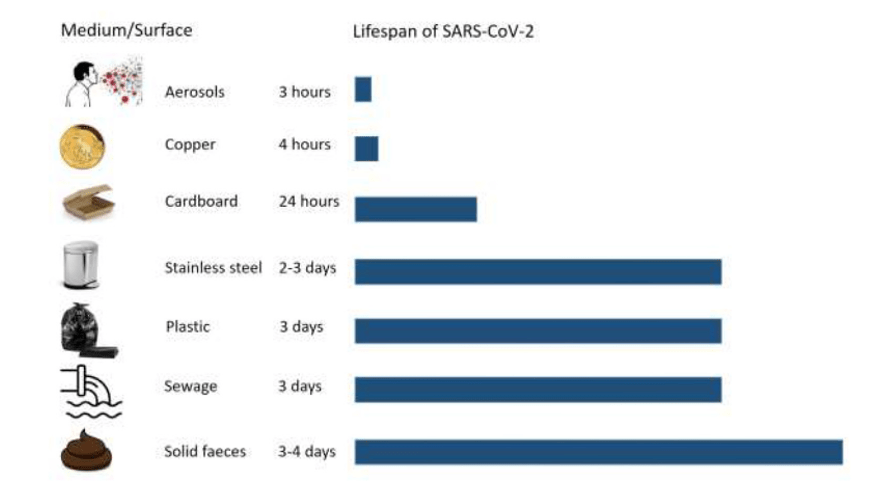Wastewater: A New Hope for War Against the Pandemic?

Severe acute respiratory syndrome coronavirus 2 (SARS-CoV-2), most commonly known as the novel coronavirus has already taken a death toll of more than 100,000 in the United States with the number of infections approaching 2 million people. A series of crucial setbacks in the COVID-19 (COronaVIrusDisease-2019) testing has made it difficult to keep up with the rapid spread of the virus and has inspired researchers around the world to investigate the presence of virus in wastewater. Scientists think that such information will help measure how prevalent the novel coronavirus is in each community. While the presence of diagnostic and blood-based testing methods is critical, these tests are for individuals and do not provide useful information on the existence of the disease within a community, a county or a city. Fortunately, there is another source for municipalities and decision makers to ensure their communities are safe – their wastewater.
In April, what had been only intriguing laboratory research of analyzing wastewater for COVID-19 detection has now quickly soared to the threshold of the real world. Wastewater analysis is thought to provide a faster and promising alternative to detect infections within a community as opposed to swab tests and contact tracing which are still plagued by capacity issues, inaccuracy and slow turnaround time. It has been predicted that when states and regions start to ease lockdown, there will be another wave of coronavirus. Laboratories around the world including the United States, Australia, and the Netherlands, have shown that the ‘genetic signal’ for the presence of virus can be detected in wastewater as early as a week prior to the first clinical case. These laboratory methods rely on detecting RNA (Ribonucleic Acid), the genetic material of the virus that is responsible for spread of the disease, in wastewater.
Wastewater analysis for infectious viruses

Detection of viruses in wastewater is not new to the scientific community. Transmission of viruses from feces of individuals into sewage has been studied for poliovirus, adenovirus, hepatitis, and norovirus (Hellmer et al, 2014). In 2005, the possibility of transmission of SARS coronavirus through feces of infected individuals into the sewage system was identified in a peer reviewed research study. The coronavirus variant responsible for COVID-19 is primarily a respiratory virus and hence, knowledge of the presence of this virus in feces of infected individuals is limited. However, some early studies have shown evidence of the presence of a COVID-19 genetic marker in wastewater. In these circumstances, it is important to avoid any misleading information and understand that, clinically, presence of a genetic marker of the virus does not mean the virus can transmit to individuals through water. The presence of genetic markers indicates an inactive or degraded form of the virus that has been detected in wastewater from already infected patients. However, it is critical to note that the virus may not always be directly released into wastewater through feces but can also be carried through infected cloths, plastic materials, and other household items that could illicitly enter the wastewater stream. As most recently observed, masks, gloves, and other personal protective equipment (PPE) used by infected people and medical workers are also entering water at an increased rate. Some recent studies have also shown that the virus can survive in wastewater for up to 3 days (Figure 1) making it more crucial for researchers to investigate this issue further.
Purpose of the viral data collection from wastewater
During a Water Research Foundation’s online seminar for congressional briefing of the environmental surveillance of the genetic footprint of COVID-19 in sewersheds, the foundation’s CEO Peter Grevatt, outlined the purpose of the data collected from wastewater analysis as follows:
- Assessment of the level of community infection. Wastewater based detection methods can be extremely helpful in tracking prevalence of infections within a community by identifying hotspots. These methods could also help identify communities that are not impacted.
- Finding the trends or changes in infection. This can also serve as an early warning indicator. It is also possible to study trends in viral infection after medical and social interventions.
- Risk Assessment. In addition to tracking risk of infection in the community, it would be possible to assess health risks for utility workers and persons handling raw sewage.
With success in research efforts, the data from wastewater analysis has the potential to reveal the true scale of coronavirus outbreak.
Testing and Quantification of Coronavirus Infections through Wastewater Analysis
A common method for detecting the novel coronavirus is nucleic acid (i.e., genetic material of the virus) testing real-time polymerase chain reaction (RT-PCR) technology. Even though primarily used for clinical samples, these RT-PCR techniques can be modified and adapted to detect and quantify the virus in environmental samples such as wastewater (Nghiem et al, 2020). Wastewater can be tested by identifying and quantifying the number of gene copies present in a liter or a gallon of wastewater as well as by calculating the fecal shedding rate of these gene copies from an infected person. After these genetic quantifications are done, the following equation is used to approximate the number of infections in a given community (WRF, SNWA 2020):

The above method of detecting virus in wastewater has a significant correlation with clinical data but needs further refinement to include various other parameters that could affect the presence of viral markers in wastewater. One such uncertainty is that, even though there is some evidence that the respiratory virus can propagate through other systems in the body such as the digestive system, this might not be true for all infected individuals. Also, the shedding rate of virus into feces changes with the progression of infection. As the clinical understanding of the virus evolves further, these tools offer a promising and fast alternative solution to diagnostics. Despite its current limitations, this promising finding could present significant opportunities to the water sector.
Opportunities for the wastewater utilities to inform pandemic responses
By careful selection of sampling points in the sewer network and analysis of wastewater, it would be possible to obtain information on varying population sizes such as a hospital, quarantine facility, university, prison or any large catchment. Even though difficulties exist with the current research understanding, they do not preclude the use of wastewater as a semi-quantitative early detection system for re-emergence of the novel coronavirus. Wastewater testing potentially could act as an ongoing tool for informing jurisdictional policy response to the management of COVID-19. For instance, routine wastewater testing could be used as a guiding tool to inform when to restrict movement of people or when to reopen or close businesses. Having such information available in real-time would have substantial economic value given the daily cost of COVID-19-related lockdowns. Wastewater monitoring has been identified as a tool to detect illegal drug hotspots (Li et al., 2019), and provide early warnings of chances of outbreaks of pathogenic viruses such as Hepatitis A and Norovirus (Hellmer et al, 2014). With some initial promising results of the novel coronavirus quantification, it is highly likely there could be similar potential value in using wastewater-based epidemiology or ‘environmental surveillance’ to inform future pandemic responses.
Related Resources:
Randazzo, Walter et al. 2020. “SARS-CoV-2 RNA in Wastewater Anticipated COVID-19 Occurrence in a Low Prevalence Area.” Water Research 181: 115942. https://www.sciencedirect.com/science/article/pii/S0043135420304796 (June 7, 2020).
Nghiem, Long D., Branwen Morgan, Erica Donner, and Michael D. Short. 2020. “The COVID-19 Pandemic: Considerations for the Waste and Wastewater Services Sector.” Case Studies in Chemical and Environmental Engineering 1: 100006. https://www.sciencedirect.com/science/article/pii/S2666016420300049 (June 7, 2020).
American Water Works Association. 2020. “The Financial Impact of the COVID-19 Crisis on U.S. Drinking Water Utilities.” American Water Works Association Illinois Section2. https://www.awwa.org/Portals/0/AWWA/Communications/AWWA-AMWA-COVID-Report_2020-04.pdf.
WRF. 2020. “Virtual Congressional Briefing on Environmental Surveillance of the Genetic Fingerprint of COVID-19 in Sewersheds | The Water Research Foundation.” https://www.waterrf.org/event/virtual-congressional-briefing-environmental-surveillance-genetic-fingerprint-covid-19.
- Water’s Role in Environmental Health

